| The Holy Trinity Theory | The three together (Morpheus, Neo, Trinity) are necessary to conquer the matrix — the three in ONE. They may have powers against the matrix that others do not. |
| Temet Nosce“Know Thyself”
Appearance |
– The phrase “Know Thyself” -I am reading ‘Octavius’ by Minucius Felix (a Latin book, written around 200 A.D.) and in the Notes I came across the phrase ‘Know Thyself’ (which doesn’t actually have anything to do with the book ‘Octavius’). The translator (a professor) said that the phrase came from Thales (I don’t know if he is also called so in English) and that what he actually meant with it was:
“…know that you are an (earthbound) human, and not a (high) god.” I thought that was very striking and somewhat of a remarkable paradox, looking at the context of the phrase in the movie. -from Isil’zha from Holland |
Christian Symbolism in The Matrix
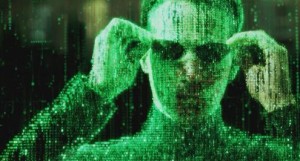 By Mark Turner (via)
By Mark Turner (via)
The movie The Matrix was certainly a science-fiction/action thriller. However, many of us also found it to be deeply profound, carrying meaningful threads of thought and truth on the most intense philosophical and spiritual levels. For some, the movie was a catalyst for a fundamental paradigm shift. For me, the film helped free my mind by suggesting a new frame of reference that has allowed me to more clearly perceive truth. This page is a journal of my own observations and interpretations, from a Christian perspective, many of which are selections of posts made to various online bulletin boards. Maybe the thoughts that follow will in some way help guide you in your own search for truth.
There Is No Spoon
If I have anything profound to offer on this web site, it is probably this, so don’t miss it! What we consider to be the real world is in actuality just a Matrix! Our eternal self does not belong to this world. We are merely visitors in a temporary illusion known as life. “So we fix our eyes not on what is seen, but on what is unseen. For what is seen is temporary, but what is unseen is eternal.” (2 Corinthians 4:18) We cannot perceive the eternal realm of which we are citizens while “confined” to this life, but we are told of its existence. This is not to say that our time spent in this world is for naught. Quite the contrary. We each have a role to play and a purpose to serve while we are here.
When we, through death, unplug from this world, all that we knew as “real” will be gone. Our possessions, our career, everything. Our eyes will be opened for the first time. “Now we see but a poor reflection as in a mirror; then we shall see face to face.” (1 Corinthians 13:12) Imagine the moment we “awake” and are able to look back on our previous experiences through a clear lens. Our relationships, our jobs, our fame and fortune, joys and pains, happiness and grief, will all fade into insignificance. The events in our life won’t really matter anymore, at least, not in the sense we are accustomed to. As Neo said on his way to the Oracle, “I have these memories from my life. None of them happened. What does that mean?” What WILL matter, then, is who we find ourselves facing at this moment; Christ, and our fellow brothers and sisters seen for who they are for the very first time. Our real purpose in this life is to get to know the God behind the matrix, and to help others unplug from the world and plug into Christ.
Reality Verses Truth
Reality is in some sense dictated by our beliefs and our environment. Before moving on, I need to differentiate between Truth and Reality. There can be many realities, but there is One Truth. For example, to those who are plugged into the Matrix and not yet aware of it, the Matrix is reality. However, the Truth is that they are serving as a 120V battery in a pod full of green slime. If I am anorexic, then I see myself as overweight; that becomes my reality. The Truth is that I am gradually starving myself to death.
The problem, then, is when my reality is not in accord with the Truth. Either I am unaware of the Truth, or I am ignoring the Truth by conscious effort. To those who cannot see the Truth, whose eyes have never been opened (still in the pod), there is no choice. That is to say, the only choice available is one reality over another, one Matrix or another if you will. Yet there can be an awareness, a searching for the Truth. God has planted within each human the desire for purpose, for meaning; a thirst for the Truth. As Trinity whispered to Neo, “It’s the question that drives us.”
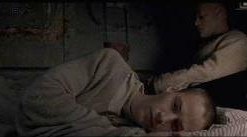 The Truth, once perceived, may not be to our taste. It may not always be convenient or pleasant. It may require sacrifice and hardship. Was the truth, the real world, what Neo expected at all? If he had known what his first days in the real world were going to be like, would he have still taken the red pill? Cypher admits he would not, “Why didn’t I take the blue pill!” What made this sacrifice (of the bliss of ignorance) worthwhile? If he was to spend the rest of his days eating tasteless glop and running away from sentinels in underground sewers, with no other purpose than to exist as a post-coppertop, he would likely regret his decision each and every day. What kept Neo going was his purpose, his destiny as the One.
The Truth, once perceived, may not be to our taste. It may not always be convenient or pleasant. It may require sacrifice and hardship. Was the truth, the real world, what Neo expected at all? If he had known what his first days in the real world were going to be like, would he have still taken the red pill? Cypher admits he would not, “Why didn’t I take the blue pill!” What made this sacrifice (of the bliss of ignorance) worthwhile? If he was to spend the rest of his days eating tasteless glop and running away from sentinels in underground sewers, with no other purpose than to exist as a post-coppertop, he would likely regret his decision each and every day. What kept Neo going was his purpose, his destiny as the One.
When we turn from the Truth and return to pseudo-realities, it is either because we fear the hardships and responsibilities that freedom brings, or we lose sight of the higher purpose we serve as one “unplugged”, or we just plain find the truth unpalatable. Consider the Matrix of New Age philosophy; that we are all divine and that the path to immortality is whatever you want it to be. Which reality is more appealing, that I am a lowly sinner in need of grace and redemption, or that I am god? When seeking the Truth we are often confronted with painful questions, whose answers may be just as painful.
Science Verses Spirituality
Another perspective from which the entire film can be interpreted: the AI represents the followers of science (governed by logic, deduction and rigid principles); Neo and the resistance represent the followers of spirituality (governed by faith in a higher power, compassion and love).
Science has become the Matrix of choice for many. Most people will accept as fact (as reality, or Truth) any statement made by anyone associated with the scientific community. Why is this so? Because science is supposedly based on objective principles and verifiable data. The scientific method: form a hypothesis (a model), perform experimentation and gather data, and evaluate the model against the results.
However, to what extent can any model be proven to be a perfect representation of that which it seeks to describe? At best, the model may reasonably predict reality under certain conditions and based on a set of assumptions. Chaos theory tells us that most systems are too complex to be represented by such models. There will always be unexpected perturbations in the system that have no apparent cause, and that drastically affect outcomes. (Weather prediction is a good example of this).
So, what most people believe to be “proven” scientific theory is really just accepted hypothesis. Now, belief in something which cannot be proven is “faith”! It takes just as much faith to believe in the “big bang” theory that is does to believe in “creation” theory!
Many people “believe”, or accept, science because they are TOLD to! Thus, science becomes a Matrix; a virtual representation of reality that prevents “external” perceptions of the Truth.
What is extremely ironic is the scientific ridicule of mysticism. Because there are events that cannot be explained by current scientific theory (spiritual healings, Jesus walking on water, etc), science declares such events to be “ridiculous” and attributes them to myth or hallucination. In other words, the scientific method is abandoned and hypothesis are accepted as fact despite evidence to the contrary! In order to justify itself, science relies on faith! Ha!
The truth is that these “supernatural” events reveal the shortcomings of the model. Only when we allow ourselves to question science do we begin to free our minds from this Matrix.
A Metaphor for the Holy Spirit
Despite an awareness of Truth, we are unable through our own powers of intellect to know or accept the Truth. We cannot “unplug” ourselves from the reality of this world, as represented by the Matrix. Matthew 13:13 “Though seeing they do not see; though hearing, they do not hear or understand.”
Somewhere it is mentioned in the film that Neo has been searching for Morpheus for the last couple of years, while Morpheus has been searching for Neo his whole life. If we view Neo as the person rather than the One, and Morpheus as God the Father, we have a nice metaphor for the relationship between God and man. God desires to have a relationship with us, from before we were born even. He is reaching out to us our whole lives.
When we seek God, he will reveal himself to us. “Seek and you will find, knock and the door will be opened…” Notice how Morpheus first contacted Neo (through Trinity, the Spirit) rather than the other way around. This was done via the computer screen when Neo is first introduced. “Wake up, Neo! The Matrix has you!” Translated, “wake up, sin has you!” God reaches out to us first.
It is interesting that this scene is followed by “Knock, knock…”, then the door to Neo’s apartment is opened. This moment is critical because the invitation is extended to Neo to join the group, and thus “follow the white rabbit.” It is this decision that paves the way for Neo to eventually establish a relationship with Morpheus. When Christ knocks on the door to our hearts, he follows with an invitation to “follow him”! If we do, we will enter into a relationship with the Father.
Only God can “unplug” us by the working of the Holy Spirit within, realigning our hearts and minds and opening our eyes for the first time. The Holy Spirit acts like the red pill, the trace program that Neo swallowed, which altered his input/output carrier signal. It was this change in his system that allowed him to “awaken” and perceive the truth. Now, as a “free moral agent,” he has the choice to accept and live by the Truth, or to follow Cypher and plug back into the Matrix. See Luke 8: 12-15.
Fate, Destiny and Free Will
The Oracle knew that Neo was the One. She predicted his death as Thomas Anderson and resurrection as the One. Why did she seem to imply he was not the One? Consider the scene when Neo breaks the vase. The Oracle could not tell Neo he was the One, for the reason that Neo would then begin to think he was the One and act like he was the One. In doing this he would be distracted from ever KNOWING that he was the One. The truth of his nature had to be self-discovered from within. The significance of the vase was to provide a parallel for this critical point. Because the Oracle told him he would break the vase, he did! Self-fulfilling prophecy!! The Oracle needed him to BE the One rather than trying to BECOME the One.
Was Neo’s future therefore determined? Was he not “in control of his own life?” Was he thus dispossessed of free will?
The role did belong to Neo, but he had to consciously accept that role all the same. The oracle could “see” the future in the sense that she could perceive the choices that Neo would make; that Neo would, at some point, accept his destiny. As Morpheus says, “I can only show you the door, you must go through it.”
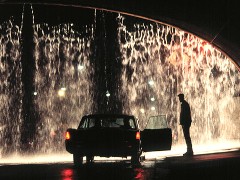 Notice the frequent symbolic use of doors in the film.
Notice the frequent symbolic use of doors in the film.
*Neo chooses to answer the door and follow the white rabbit.
*He declines to flee the office building through the exterior window (just a different type of door)
*He enters through the car door to be taken to Morpheus, and later decides not to exit the car.
*He enters the door to the apartment when meeting Morpheus.
*He enters the door to see the Oracle.
The list goes on. Thus, fate becomes a path which leads us through a sequence of doors; at each door we must make a decision, and each door that is opened leads to another door. This series of doors will describe a unique path for each person, our destiny. The gift of the Oracle is the ability to see through all the open doors, and therefore know the future by knowing each decision that is made.
Each of us creates our own future, moment by moment, one decision after another. I believe we have complete and unrestricted free will. As each decision is made, a path is created. At each moment of our lives we face an infinite number of choices, an infinite number of doors, any one of which we choose to open. As we progress through life, we leave a “trail” of these open doors representing our decisions. To someone who is able to perceive the entire trail from birth to death, my life becomes predictable, in fact predetermined if viewed from the beginning! I therefore define my fate, my destiny, to be this path.
A Metaphor for the Duality of Christ
The quotation “You seem to be living two lives, Mr. Anderson,” led me to consider the duality of Christ. Christ, being both fully man and fully God, did possess two distinct natures and exist on two different planes. One the one hand he was a part of this world, subject to its laws and manifestations. He “obeyed the system” so to speak. On the other hand he is above this world, with the knowledge and power to create and/or manipulate this world as he pleases (although it wasn’t until later in his earthly life that he began to reveal those powers). Similarly, Neo lived as both a follower of the system (Thomas, an employee of a respected firm) and as a hacker (in opposition to the system). It is interesting that Christ was considered a criminal by many, and ultimately put to death as such. As Neo pursued his “hacker nature”, his true powers as the savior began to manifest themselves.
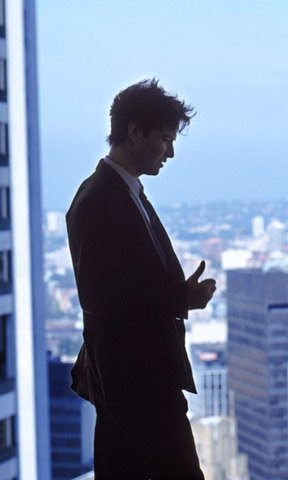
A Metaphor for the Struggle Against Sin
Consider the scene where Neo is at the office and the agents come looking for him. Morpheus, via the cell phone which arrives just in the nick of time, provides Neo a means of escape through the window to the scaffolding. A metaphor for God’s promise to always provide a means of escape from temptation.
Sin (the agents) often “comes for us” when we least expect it. God promises a way out. 1 Corin 10:13: “But when you are tempted, He will also provide a way out so that you can stand up under it.” This “escape route” may be difficult, it may require faith, and it may come at the last minute. Neo had the will but not the faith. He was afraid of falling. The result was that he surrendered to the agents and experienced the consequences (the interrogation scene).
What often keeps us from avoiding temptation is our own fear of falling; we convince ourselves we are not able to resist and expect ourselves to fail. We stop listening to God and concentrate on our own weaknesses, just as Neo dropped the phone (his communication line with Morpheus), took his focus off the scaffolding, and turned his eyes downward to the street. I guess the scaffolding could represent the Word. If we surrender to sin, the consequences will be painful (if not to our body, then to our soul). Sin will “infect” us like a bug, separating us from God. Just as Neo had to be debugged before he was permitted to see Morpheus, we must be cleansed of sin to enter into the righteousness of a holy god.
Christian Symbolism in The Matrix Reloaded
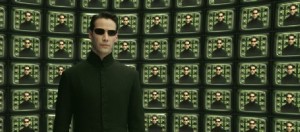 By Mark Turner (via)
By Mark Turner (via)
In The Matrix Reloaded, the roles of Neo and Agent Smith become even more focused and more clearly defined as representing the Christ and Anti-Christ. (Unlike your typical western, in this case both the good guy and the bad guy wear black.)
Christian Symbolism in The Matrix Revolutions
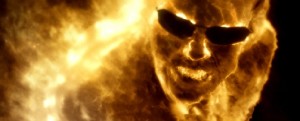 By Mark Turner (via)
By Mark Turner (via)
In The Matrix Revolutions, the final battle between good and evil plays itself out. Although the third film of the trilogy seems preoccupied with being an action film, Christian symbolism continues to be a very strong thread tightly woven into the plot. Those searching for elements of truth from these films will find much to discover here.
Revolution or Revolution?
One question that comes to mind about this film is the meaning of the title. Is it revolutions, as in the French Revolution – a change in or overthrow of the current ruling class? Or is it revolutions, as in a complete rotation – to come full circle and return to the position from which you started? I believe it is both, and that both are representative of the victory of Christ on the cross.
First, there is the obvious revolution in which the citizens of Zion strive to overthrow the tyranny of the machines. They are like the Israelites, the “chosen” people, for no one could be freed from the Matrix unless they were selected and given the opportunity by someone from outside the Matrix (just as Neo was chosen by Morpheus). Their desire is not just to end the war between themselves and the machines. They desire for all humans to be free from bondage, to free their bodies from the pods and free their minds from enslavement within the Matrix. We were also slaves at one time – slaves to sin. Our sinful nature kept us under the dominion of Satan. On our own, there was little chance of escape (a few Israelites, through the old testament law, made it). Through the sacrifice of Christ, the tyranny of our sinful nature was overthrown and we could once again be at peace with God. In the same way, Neo is the vessel which breaks the bonds of enslavement to the Matrix. Notice how, like Christ, Neo willingly offers himself as a sacrifice in order to restore peace between man and machine. Notice how Neo allows Smith to imprint him. He becomes Smith, just as Christ “became” sin on our behalf: “He himself bore our sins in his body on the tree, so that we might die to sins and live for righteousness; by his wounds you have been healed.” (1 Peter 2:24)
The end of the movie also suggests having come full circle as the Matrix is restored and everything appears to be exactly as it was when the first film began. However, it is only an appearance of sameness, for a great change has indeed taken place that is as subtle as it is powerful. For one, the Zionites are no longer at war. More importantly, all of humanity, not just the people of Zion, have benefited from Neo’s sacrifice. Those still plugged in did not suddenly become unplugged (imagine the shock), but instead have been given a choice. They can, if they wish, leave the Matrix and their pod to become a citizen of Zion. It is this choice that is the central and foremost theme of the film series, and the primary difference between man and machine: freedom means the ability to choose. Similarly, humanity came full circle at the crucifixion of Christ. Did the world appear drastically different after his crucifixion and resurrection? Not at all, contrary to expectations. The world appeared exactly the same, and for most the event went unnoticed. However, a great change had taken place. We were restored to our original state as typified by Adam and Eve before the fall – sinless and therefore at peace with the almighty God. We are no longer his enemies. We are no longer helplessly bound to sin. We can choose, choose to deny our sinful nature and enter the kingdom of God as one of his children by accepting the redemption found in Christ. And most importantly, this choice is extended to all people, not just the Israelites.
Good Nature Verses Sinful Nature
On one level, I believe the Architect and the Oracle may be two sides of a single nature. As programs, they may serve to function as the mind and heart of a single consciousness, that consciousness being the AI (the Deus Ex Machina). The Architect (father of the Matrix), whose actions are cold and calculating, dictated by logic and reason, represents the mind. To the Architect, everything must make sense. The “equation” must be balanced. Life must be predictable, each event determining all that follow like dominoes falling one after another. On the other hand, the Oracle (mother of the Matrix) represents intuition, irrational thought, emotion, and spontaneity. The Oracle is all about choice. Choice, or decisions, require the option to step outside of reason and perform an illogical act. In the words of the Architect (Reloaded), “the problem is choice…the onset of an emotion, designed specifically to overwhelm logic and reason.” To the Oracle, life is full of change, chaos, unpredictability; imbalance as it were. The oracle is the AI’s attempt to mirror the illogical side of human nature.
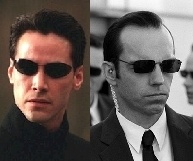 Then, we have Neo and Agent Smith. On one level Christ and Anti-Christ, on another level a single nature once again divided into two equal but opposite forces. Both pieces of a larger whole; two subprograms battling for control of the mother program, two “children” of the Oracle. Neo represents the good nature of the Oracle, that which desires to do what is right. Even Agent Smith describes him this way during the interrogation scene in the first film: “…but I believe you wish to do the right thing.” Notice how Neo always places the needs of others before his own needs. Smith, on the other hand, represents the evil nature of the Oracle, driven by greed and the thirst for power. Observe how Smith is the model of wanton selfishness; it’s all about him.
Then, we have Neo and Agent Smith. On one level Christ and Anti-Christ, on another level a single nature once again divided into two equal but opposite forces. Both pieces of a larger whole; two subprograms battling for control of the mother program, two “children” of the Oracle. Neo represents the good nature of the Oracle, that which desires to do what is right. Even Agent Smith describes him this way during the interrogation scene in the first film: “…but I believe you wish to do the right thing.” Notice how Neo always places the needs of others before his own needs. Smith, on the other hand, represents the evil nature of the Oracle, driven by greed and the thirst for power. Observe how Smith is the model of wanton selfishness; it’s all about him.
One cannot exist without the other. Choice demands the existence of both. You cannot choose to do good unless there is an opposing option to perform evil. Each defines the other. The Oracle was clear about this in referring to Neo: “He is you. Your opposite, your negative, the result of the equation trying to balance itself out.” The Oracle acted like a conscience, trying to guide the good nature (Neo) in the right direction while at the same time trying to resist or suppress the evil nature (Smith). Notice how the battle between these natures is fought until, at the bottom of the impact crater, the three eventually merge together when the Smith/Oracle entity imprints Neo. United at last, the battle ends and we see the Oracle, the symbol of the heart and choice, is all that remains. She is once again whole. This time, goodness has triumphed over evil. The Architect refers to this battle of the two natures at the end when he says, ” You’ve played a very dangerous game.” Also Neo, “Choice. The problem is choice.” By introducing choice, the Oracle introduced the potential for evil to triumph over good.
Is it any surprise that Neo is part program? More likely, Neo is the body of some ordinary human whose mind was imprinted with the “good nature” subprogram of the Oracle early on, just as the agents were able to take control of any body plugged into the system. The “Neo subprogram” was necessary for the system to work, as explained by the Architect: “Your life is the sum of a remainder of an unbalanced equation inherent to the programming of the Matrix.” It needed to be imprinted on a human for the same reason Christ needed to be human – it was the only way for the sacrifice to work at the end, allowing good to have victory over evil. Christ was part God, part man. Neo is part machine, part man. Here is further evidence for my analysis.
1. Consider the following dialogue between Neo and the Oracle:
Oracle: I told you before. No one can see beyond a choice they don’t understand, and I mean no one.
Neo: What choice?
Oracle: It doesn’t matter. It’s my choice. I have my mind to make, same as you have yours.
Then again:
Neo: Who decided it wasn’t time?
Oracle: You know who. *She points at the Temet Nosce sign above the door*
Neo: I did. *Oracle nods*
The Oracle can’t see beyond Neo’s choice because it really IS her choice, as Neo is a part of her nature. The second conversation sure has the tone of a conscience speaking to itself.
2. Agent Smith referred to the Oracle as “Mom”. His maniacal laughter after imprinting the Oracle could be his realizing in a moment of irony that, in a sense, he and the Oracle had always been one and the same.
3. In Reloaded, the Architect tells Neo that he must “return to the Source, allowing a temporary dissemination of the code you carry, reinserting the prime program.”
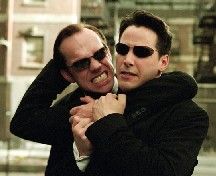 Each of us, like the Oracle, have two natures that are waging war with one another over control of our hearts. “For what I do is not the good I want to do; no, the evil I do not want to do- this I keep on doing.” (Romans 7:19) Our good nature, bolstered by the power of the Holy Spirit, is the result of allowing Christ to rule our hearts. It is the source of love. It cherishes life. It always seeks to do the right thing, and places the needs of others as first priority. Our sinful nature, however, is ruled by selfishness and pride. When we allow Satan to rule our hearts, the result is hatred, bitterness, and envy. Our sinful nature seeks to destroy life. One of our two natures will eventually win. Through Christ, we can allow the power of the almighty God to conquer our evil nature and free us from the power of sin.
Each of us, like the Oracle, have two natures that are waging war with one another over control of our hearts. “For what I do is not the good I want to do; no, the evil I do not want to do- this I keep on doing.” (Romans 7:19) Our good nature, bolstered by the power of the Holy Spirit, is the result of allowing Christ to rule our hearts. It is the source of love. It cherishes life. It always seeks to do the right thing, and places the needs of others as first priority. Our sinful nature, however, is ruled by selfishness and pride. When we allow Satan to rule our hearts, the result is hatred, bitterness, and envy. Our sinful nature seeks to destroy life. One of our two natures will eventually win. Through Christ, we can allow the power of the almighty God to conquer our evil nature and free us from the power of sin.
The Source
The Source is symbolic of God, the source of all light and life. Neo was able to tap into the energy of the Source to perform “miraculous” works, such as when he stopped the sentinels at the end of Reloaded. The Oracle confirmed this ability:
Neo: Tell me how I stopped four sentinels by thinking it. Tell me just what the hell is happening to me.
Oracle: The power of the One extends beyond this world. It reaches from here all the way back to where it came from.
Neo: Where?
Oracle: The Source.
As the Son of God, Christ could also tap into a source of power beyond the world we perceive and perform miraculous works, such as the ability to perform wondrous healings, cast out demons, etc. He often did things that could not be explained.
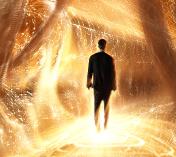 The Source was located in the machine city. Notice how the machine city is characterized by light, an abundance of brilliant, blinding light. Just as the Matrix is a symbol of this world, the machine world is a symbol of the kingdom of God. Heaven, the dwelling place of the source of light which is God. This is why Neo could not go to the Source until he was ready. He had a mission that needed to be completed first. Instead, he found himself in the Train Station, a place halfway between the Matrix and the machine city. The Train Station represents Limbo (note the anagram for “Mobil”), a “waiting room” between Heaven and Earth where those who have passed from this world lay “sleeping” until the great day of Christ’s return. Notice how Neo was sleeping, as in a coma, while he was in the Train Station. In like manner, Christ could not ascend into Heaven until he had completed his mission here on Earth. For both, this mission was to make the ultimate sacrifice. Christ on the cross said, “It is finished.” The Deus Ex Machina, following the death of Neo, said, “It is done.”
The Source was located in the machine city. Notice how the machine city is characterized by light, an abundance of brilliant, blinding light. Just as the Matrix is a symbol of this world, the machine world is a symbol of the kingdom of God. Heaven, the dwelling place of the source of light which is God. This is why Neo could not go to the Source until he was ready. He had a mission that needed to be completed first. Instead, he found himself in the Train Station, a place halfway between the Matrix and the machine city. The Train Station represents Limbo (note the anagram for “Mobil”), a “waiting room” between Heaven and Earth where those who have passed from this world lay “sleeping” until the great day of Christ’s return. Notice how Neo was sleeping, as in a coma, while he was in the Train Station. In like manner, Christ could not ascend into Heaven until he had completed his mission here on Earth. For both, this mission was to make the ultimate sacrifice. Christ on the cross said, “It is finished.” The Deus Ex Machina, following the death of Neo, said, “It is done.”
The Deus Ex Machina (DEM), the face of the AI, is symbolic of the “face of God.” Similar to the burning bush for Moses, it is a visual manifestation of God that permits direct physical interaction. Consider the literary definition of this term:
DEUS EX MACHINA (from Greek theos apo mechanes): An unrealistic or unexpected intervention to rescue the protagonists or resolve the conflict. The term means “The god out of the machine,” and refers to stage machinery.
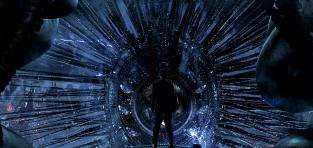
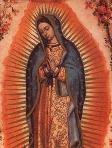
The Heavenly Realms
Consider the scene where Neo and Trinity are traveling in the Logos towards the machine city, and Neo is attacked by a sentinel that seems to “pass through” the ship as some form of energy. A possible interpretation of the parallels here is that the sentinels represent the dark forces of the spiritual realm: “For our struggle is not against flesh and blood, but against…the powers of this dark world and against the spiritual forces of evil in the heavenly realms. In addition to all this, take up the shield of faith, with which you can extinguish all the flaming arrows of the evil one.” (Ephesians 6:12, 16)
I think we saw a “flaming arrow.” Neo (as Christ figure), blinded to the physical world, is now more sensitive to the “spiritual realms” and thus more susceptible to attack from this direction. Notice how he is surrounded by darkness in this scene, suggestive of the “dark world.”
A Promise Made
At the end of the film, we observe a colorful sunrise within the matrix. This is a first; the matrix has never been host to such use of color. The event is therefore of great significance. The designer of the sunrise, Sati, claims it to be a tribute to Neo. This scene transpires after Neo’s sacrifice and immediately after the Architect has made his promise of peace. The sunrise is symbolic of the rainbow, a sign of God’s covenant to never again destroy the Earth with a flood. The Architect, spokesman for the machine city, has promised not to destroy Zion and to allow the human race to coexist peacefully. (Credit is given to Zeo for discovering this symbolism.)
Reaction to Mark Turner’s articles:
George Wayne
(via)
Was looking at your web site’s comments re: Matrix- it’s very insightful. I think there may be one overall comment worth making on the theme that is woven in your commentary: “Life is not what it seems!”
Actually, reality IS knowable for the Christian (Col 2:8)– the world is knowable (Rom 1)– it is not a Matrix per se, but what God has made, just as we are. I think that some care has to be taken to not weaken the Christian epistemology– we CAN know things– That is, we are created with reliable sense mechanism, with operational inferential faculties and given incomplete knowledge, but real knowledge just the same, about certain transcendent aspects of God and His shining city…
An analogical worldview is fine, but it depends upon reasoning from attributes of this world and our nature toward the future world and our Maker. Yours seems to make some conclusions from the movie, thus going the other way [this road ends up in a Hinduistic-like syncretism if taken to its logical conclusion].
Otherwise, you have many fine insights.

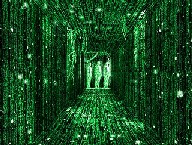
Be the first to comment